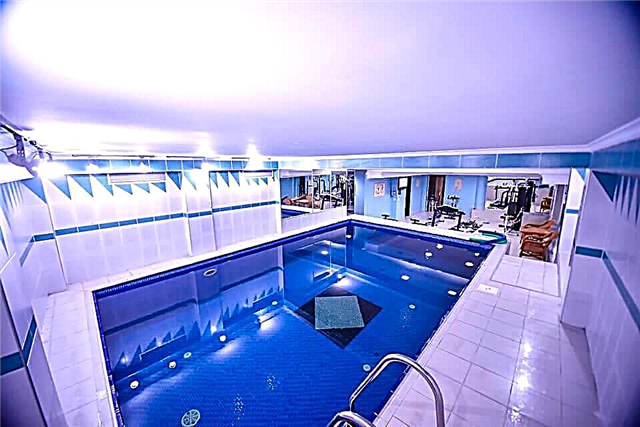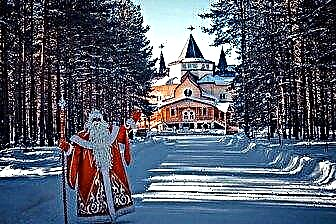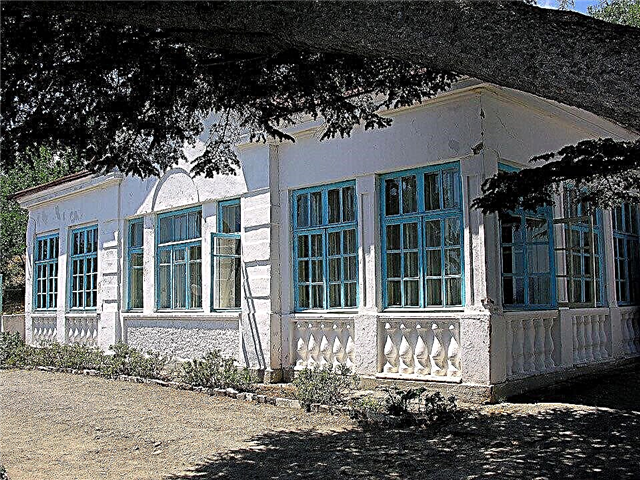The resort town of Alushta is located on the southern coast of Taurida - one of the pearls in the crown of the Crimean peninsula. The name of the city comes from the ancient Greek word Alusta, which means chain.
The unique subtropical climate of the Mediterranean character is in many ways similar to the temperature conditions of Yalta, only slightly cooler. Like all ancient settlements of Crimea, the city is filled with interesting places.
From what to see in Alushta in 1 day, you have to choose the sights of the most preferred individual tastes of travelers. You need to start from the embankment of the resort, visit the rotunda, visit the Seaside Park.
You can continue your self-guided tour by visiting an Orthodox church and visiting the local mosque. Below is a brief description of the significant places that you can visit and see during the day.
Embankment and rotunda

The center of attraction for the guests of the resort is the embankment. It is considered the longest and most beautiful coastal promenade in Crimea. Until the 50s of the last century, it was impossible to build on the banks of the boulevard.
The absence of breakwaters affected the constant destructive effects of stormy sea waves on the coastal strip. And only with the appearance of protective structures, the city turned a section of the old road to Simferopol into the main beautiful sight.
The end of the embankment is crowned with the symbol of the resort - its business card. The sacred building appeared on the embankment in 1951.
Despite the difficult post-war years, the city authorities approved the construction of a rotunda designed by engineer Alexander Grizo. It took three years to collect materials and funds for the construction of the colonnade. Various enterprises took an active part in the construction of the cultural facility.
Workers were allocated, the necessary materials were supplied: cement, sand, brick, lime, etc. Today, not a single vacationer will take with him a memorable photo against the background of an arch with six columns. In the evening, entertainment events are constantly held here: concerts, competitions, etc.
Park "Crimea in miniature"

The art object is an open-air exhibition. Practically the most significant sights of Crimea are collected here, embodied in copies at a scale of 1:25, 1:50 and 1: 100.The park was opened in 2012. There are more than 50 models of legendary buildings and structures on its territory. In the evening, the miniatures take on a fabulous look under the rays of beautiful illumination.
The exposition is annually replenished with new models. Each exhibit has a sign with minimum information about the object. You can take part in an excursion that lasts 1 hour. The guide will provide interesting facts from the history of each palace, fortress and religious buildings.
The park consists of two zones. The first part of the territory is occupied by miniatures, and the second area is reserved for figures of heroes of Russian and American cartoons. There are mini attractions nearby. Parents with children have a great time here. The entrance to the park is paid, but the time of stay in it is not limited.
Seaside park

The public garden next to the embankment is a favorite resting place for residents and guests of the city. Seaside Park is located between Lenin Street and the Demerdzhi River, separated from the sea by a beach strip. In summer, all entertainment complexes here are open until 23:00, seven days a week. The park is a public place and admission is free.
The central attraction of the park is the Villa Otrada - the former dacha of the merchant Stakheev. Now the house belongs to the Center for Children's Creativity.
The architectural monument of the 19th century embodied several styles of architecture at once. The snow-white facade is decorated with portals with beautiful columns. The corner tower is crowned with a dome. The whole appearance of the building evokes a feeling of lightness, airiness and creates a festive mood.
The central alley divides the territory of the park into two equal parts, at the beginning of which there is an obelisk - a monument to the first Bolshevik government of Taurida. Around the alley you can see rare plants, several types of oaks, plane trees, chestnuts and cypresses. The square is equipped with seating areas with comfortable benches.
Church of the Crimean Saints and Theodore Stratilat

The temple was built in the first half of the 19th century. The religious building was built by order of the Governor-General of Crimea, Count Vorontsov, who was conducting a campaign for the construction of Orthodox churches on the southern coast. New churches were needed because medieval buildings could no longer accommodate all Orthodox believers.
The Church of All Crimean Saints and Theodore Stratilates is located at st. Khromykh, 14. The construction of the temple was supervised by the Odessa architect Toricelli. The new architectural style of the building was defined as pseudo-Gothic. The entrance is decorated with wooden doors with unique carvings. The walls are covered with frescoes with traditional religious themes.
On the south side of the temple there is an icon with a face, one of the most revered saints in the Crimea, Feodosia of Surozh. The church was not active for a long time due to the unfolded theomachist campaign of N.S. Khrushchev in the 60s of the last century.
Only in the 80s the temple resumed services. At the same time, the previously demolished three-tiered bell tower was restored.
Yukhary-Jami Mosque

This mosque is the only religious complex of Musumal buildings in the city. Yukhara-Jami was built in the 19th century on the highest point of the city - the Fortress Hill hill. A magnificent panorama of the resort opens from a height of 40 meters. Yukhary-Jami translated from the Crimean Tatar language means the Upper Mosque. In the century before last, there was also the Lower Mosque, which was later completely destroyed.
During the years of Soviet power, the Upper Mosque experienced partial destruction and desolation. Ornamental wall paintings, wood carvings and stained-glass windows were damaged. During this time, the premises were occupied by various organizations.
Only in 1994, the temple was returned to the community of the Spiritual Administration of Crimean Muslims. Currently, restoration work is being carried out here to restore the interior decoration of the decoration.
On Fridays, prayers are performed here.
The mosque is open to everyone, but we must not forget that you cannot visit it with shoes on (you take off your shoes before entering) and open clothes. Women must have their heads covered.
House-Museum of Academician A.N. Beketova

The outstanding architect's dacha is located in Professorsky Lane. The building was erected in 1896 using the motives of Moorish architecture.
The author of the project was the academician himself, who was the founder of the Kharkov architectural school at the turn of the 19th and 20th centuries. For many years of living in Alushta, the scientist enriched the resorts of the peninsula with buildings, whose appearance is still a worthy decoration of the cities of Crimea.
The house-museum has been operating since November 1987. The exposition consists of many drawings, significant documents, photographic cards. Here you can see works of painting and graphics, personal belongings of Beketov, household items.
The furniture has been kept in excellent condition. The building was transferred to the disposal of the city executive committee by the academician's relatives - daughter and grandson.
A creative living room has been opened in the house-museum, where meetings of famous artists: artists, poets, writers and musicians are held.
Museum of the writer I.S. Shmeleva

The house where he spent four years of his life (1918 - 1922) is located next to the house-museum of Academician Beketov. The tragic fate of Ivan Sergeevich Shmelev forced the writer to spend the rest of his life in exile in France.His famous works still excite the minds of different generations. Most of his life in the tragic days of the history of his homeland.
The events of that time formed the basis of the plot lines of his works. These are the stories "Grapes" (1913), "Under the Mountains" (1907).
Already in exile, the writer finished writing the novel "The Sun of the Dead" about the terrible famine in the Crimea in 1921. The exposition reflects the history of the creation of the novel, the main stages of the writer's life. Particular attention is paid to the years of Shmelev's stay in Alushta.
Furniture, paintings, household items, books with photographs - all this creates an image of the writer's unfulfilled dream. The museum is located at: Professor's Corner, Naberezhnaya Street, 2.
Fortress Aluston

The attraction is a few surviving remnants of the once large city of the ancient era. These are three fragments of an ancient fortress, lost in a residential area of a private sector. The first tower is visible from the road next to the square.
The remains of the second tower are located next to the house number 25 on 15 April street. Finding them without the help of a guide will be very difficult. The ruins of the fortress wall are located between the towers.
The fortress was built on top of a 45-meter hill in the middle of the 6th century. Over time, a settlement was formed around the defensive complex, which later turned into a city, which later received the name Alushta. According to an ancient legend, the fortress was erected by order of the Byzantine emperor Justian I and was inhabited by the Goths.
Crimean natural reserve

The Crimean Nature Reserve is the largest protected area on the peninsula. The reserve occupies 34,500 hectares of mountainous and wooded lands, 52 hectares of the Swan Islands and 9,500 hectares of the water area of the Karkinitsky Bay. More than 80% of the territory is oak, beech and pine forests, which is 10% of all Crimean forests. 1165 species of flora grow here, 39 species of mammals live.
In the vastness of the reserve, you can see 160 species of birds. According to the latest revision, about 550 deer, 300 wild boars, 200 roe deer and 80 mouflons live in the protected area. The reserve occupies a huge territory, and it is simply physically impossible to inspect even most of it in 1 day.
Excursions are conducted during which tourists will visit a trout farm on the Alma River, see the Kosmo-Domianovsky monastery, and drink crystal water from the Savlykh-Su spring.
Then the group will pass the Chuchel Pass, from where they will admire the grandiose panorama of the peaks Roman-Kosh, Demir-Kapu and Kemal-Jegerek. Then the travelers will visit the "Gazebo of the Winds", visit the parking lot of the Crimean partisans "Red Stone" and pass through the Uch-Kosh gorge.
Dolphinarium "Aquarelle"

A dolphinarium "Aquarelle" was built and put into operation in 2013 near the trolleybus station at a distance of 250 meters from the sea. The entertainment center is open all year round.
The demonstration hall is a pool with a diameter of 20 meters and a depth of 5 meters, the bowl of which can hold 1,500 tons of water. The water arena is surrounded by 3 sectors with 700 seats. An oval transparent polymer roof overhangs the auditoriums. This makes it possible to hold performances in any weather.
The canopies can change their width. The dome in the central part remains open. Show programs are held three times daily at 12:00, 15:00 and 18:00 except Monday. For a fee, viewers are allowed to hold their own photo session, and a professional photographer is always working here.
Additional services include swimming with sea animals, you can play ball with dolphins and ride on their back.
The dolphinarium uses a unique method of rehabilitation for both children and adults. Dolphin therapy includes a set of programs that take into account the characteristics of patients' diseases. The dolphin is trained to work with each patient.
Almond Grove Water Park

In the area of the Professor's Corner there is a grandiose resort and entertainment center "Almond Grove" with the water entertainment complex of the same name. It represents the perfection of contemporary landscape design.
The water park covers an area of 2 hectares, where numerous attractions are surrounded by huge rocks with convenient paths, lush crowns of trees and tropical plants.
A festive atmosphere of comfortable rest and active entertainment always reigns here, attracting a large number of adults and children every day. The water park has 6 swimming pools, 4 platforms with slides and a VIP area. In addition, visitors can swim under the waterfalls, soak in the jacuzzi, enjoy drinks from the studio bar, moderate their appetite in fast food and accompany their offspring to the children's cafe.
The water center "Almond Grove" is open seven days a week all season from 10 am to 5 pm. Tickets can be purchased both for the whole day and from 13:00 to 17:00 and from 15:00 to 17:00.
Princess Gagarina's palace

On the western side of the resort there is a sanatorium settlement "Utyos". It is famous for one of the most beautiful castles - the Palace of Princess Gagarina. The building is made in the Art Nouveau style with the use of Gothic elements. The castle facades evoke romantic moods associated with childhood memories of the fairy tales of the Brothers Grimm, Hans Christian Andersen and Charles Perrault.
The history of the palace is very interesting. Already in old age, Prince Alexander Gagarin, on behalf of Count Vorontsov, acted as governor in the city of Kutaisi, where he met a young beauty - Princess Tasso of the ancient Georgian family Orbeliani.
She soon married a prince. The marriage was unexpectedly short-lived. The unhappy widow leaves her native place and settles in Crimea forever.
At the end of her life, the 77-year-old princess in 1902 organizes the construction of the castle according to the project of the architect Krasnov. Five years later, a three-story handsome palace appears on Cape Plaka. Since then, numerous tourists have come here to admire one of the most beautiful buildings on the peninsula.
Unfortunately, it is impossible to inspect the castle from the inside due to the location of the administration of the Utyos sanatorium in it.
After getting acquainted with the sights of the resort, there is still time, then it can be spent on visiting places such as the Jur-Jur waterfall, the Valley of the Ghosts and the valley of Sotera.
Jur-Jur waterfall

The waterfall is located at 468 meters above sea level of the Ulu-Uzen river bed near the Generalskoye village of the Alushta region. The name Dzhur-Dzhur is associated with the phonetics of the sound of the murmur of water. You can get to the waterfall by leaving your vehicle in a convenient parking lot. But the path in a straight line will be 1 km, which not everyone will be able to do.
However, you can use the services of jeep drivers who will overcome the steep bends of the mountain road, which will provide an adrenaline injection for travelers. The five-kilometer detour is good because on the way you can stop and have a photo session against the backdrop of cascades and admire the natural Bath of Youth.
We recommend the excursion: Alone with nature: Jur-Jur waterfall - take a dip in the healing baths and feel the power of nature next to the mighty waterfall
Ghost valley

Fabulous rock figures are the result of the weathering of volcanic formations on the southwestern slope of the Demerdzhi ridge. Conglomerates of the Upper Jurassic period represent the most ancient rocks that emerged on the surface of the Crimean land, the age of which, according to the assumptions of geologists, ranges from 800 million to 1 billion years.
Demerdzhi, which is 1240 meters above sea level, is a jagged mountain located north of Alushta and east of the Angarsk pass. The mountain range consists of northern and southern parts, separated by a saddle. In 1894, the southern massif of Demerdzhi collapsed. As a result, the Tatar settlement suffered, the inhabitants of which later left it.
In 1966, there was a second collapse.This phenomenon was repeated again in 19992. Clusters of rock debris formed at the site of the disaster.
Large fragments of rock debris are transformed by the power of travelers' imaginations into fantastic images of fairy-tale creatures, which gave rise to calling the area the Valley of Ghosts.
Valley of Sotera

Rock mushrooms are one of the amazing attractions of the peninsula. It is with these formations that the valley of Sotera is filled. This natural phenomenon is the result of the work of winds and water. The mushroom cap consists of several layers of hard rock, and its stem is a clay pillar “reinforced” with rock fragments.
In the process of geological shifts in this place from the ground began to "grow" stone mushrooms with a trunk up to 2.5 meters in diameter and 3.5 to 6 meters in height. At one time there were three mushrooms. In 1983, one of them collapsed. Currently, geologists have noticed the appearance of three "mushrooms" at once, the height of which is insignificant - 30-40 cm.
The Valley of the Stone Mushrooms attracts a large number of visitors every tourist season. The valley of Sotera is remarkable not only for its mushrooms, but also for its three most beautiful waterfalls.











